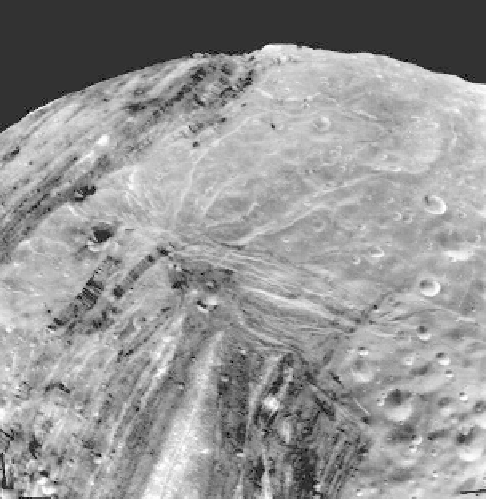Geology Reference
In-Depth Information
Figure 10.5. Part of the feature informally called the
(left
side) and sets of ridges and grooves that cut across older cratered
terrain; the area shown is 220 km across (NASA Voyager 2 PIA00038).
“
chevron
”
Figure 10.7. A mosaic of four Voyager 2 images showing the
1,159 km in diameter Ariel; as with Miranda, this moon shows
evidence of crustal deformation in the form of grabens, faults, and
smooth areas that might have been resurfaced by cryovolcanism; the
prominent graben toward the bottom of the mosaic is named
Korrigan Chasma (NASA Voyager 2 PIA01534).
resurfacing early in its history. As with Miranda, internal
heating might have been generated by tidal interactions
with other objects resulting from its orbital geometry.
Some smooth plains visible today show that resurfacing
has occurred more recently, which would re
ect internal
heating. Fractures and narrow, straight valleys, which are
likely to be grabens, indicate extensional tectonism.
Umbriel is a heavily cratered object and is the darkest
of the large moons of Uranus (
Fig. 10.8
). Its relatively
high density suggests a water-ice composition plus about
40% non-ice components, such as rock and carbonaceous
materials. Locked in synchronous rotation, Umbriel is
completely immersed in the magnetosphere generated by
Uranus, leading to intense bombardment on its trailing
hemisphere, as for Ariel. In addition to water-ice, remote
sensing data indicate the presence of carbon dioxide on
the surface, mostly on the trailing hemisphere. Voyager 2
images are of rather low resolution and cover about 40%
of the surface. There are hints of structures such as scarps,
grabens, and hexagon-shaped features, but the image
resolution is inadequate for con
rmation. Craters are
common and range in size up to the 208 km crater
Figure 10.6. Miranda
s surface has been cut by faults, some of which
form scarps as high as 5 km, as seen in this limb view (NASAVoyager 2
PIA00140).
'
it is thought to be a differentiated object. Assessments of
the crater size
frequency distributions show an absence
of large craters, leading to speculation that Ariel might
have experienced one or more episodes of extensive
-





